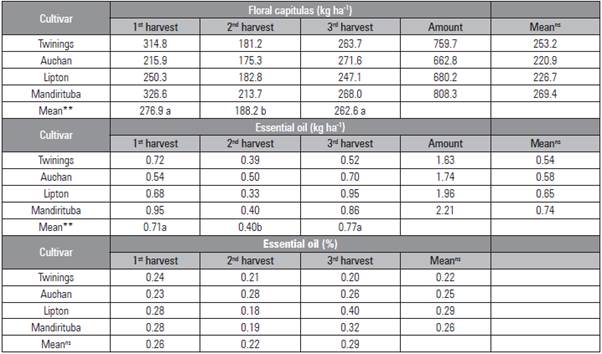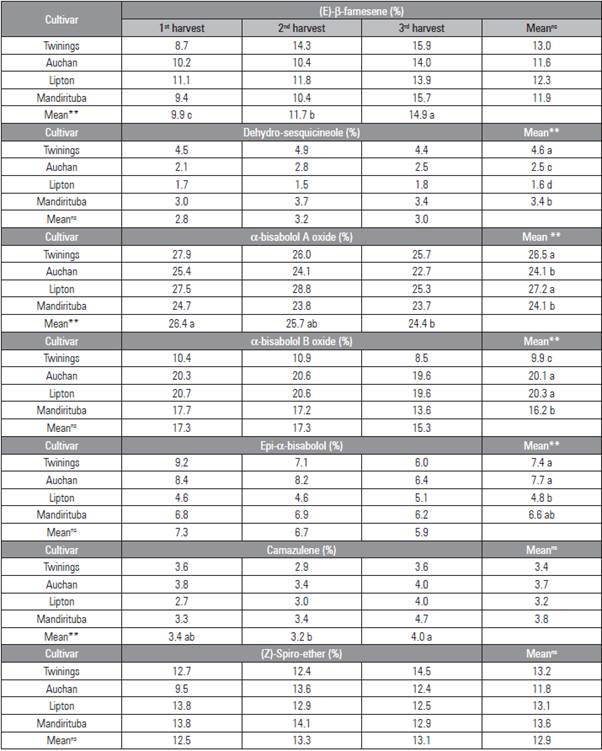INTRODUCTION
Chamomile [Chamomilla recutita (L.) Rauschert], belongs to the Asteraceae family and it is cultivated in many countries, including Brazil, with Paraná having the largest planted area (Corrêa Júnior et al., 2008) with 3,000 ha, producing an average of US$ 3.5 million per year (AEN-PR, 2016).
Chamomile is included in the pharmacopoeia of 26 countries (Salamon, 1992) and has more than 120 chemical constituents identified in the essential oil of its inflorescences (Pino et al., 2002), including 28 terpenoids, 36 flavonoids and 52 compounds with potential pharmacological activity (Singh et al., 2011). The essential oils of the different chamomile chemotypes presented the constituents cis-β-Farnesene (0.9-65.9%), spathulenol (1.3-19.4%), α-bisabolol B oxide (0.1-25.1%), α-bisabololone A oxide (0.129.9%), α-bisabolol (0.1-56.9%), camazulene (0.225.5%) and α-bisabolol A oxide (0.1-55.9%) (Tadrent et al., 2016).
The composition and percentage of the essential oil constituents of chamomile are subject to variations because of genetic and environmental factors (Tadrent et al., 2016). Research aimed at improving crop production technologies is important for increasing the production and quality of essential oil. Thus, the introduction of cultivars that adapt to regions of production can bring benefits to chamomile cultivation. The objective of this study was to evaluate the productivity of flower buds, the essential oil content and the composition of four cultivars of chamomile in three harvest periods.
MATERIAL AND METHODS
This experiment was conducted at the Experimental Stations Center of Canguiri (UFPR) in the municipality of Pinhais-PR (25°23.258' S and 40°07.713' W 919 m of altitude), where the climate is classified by the Kõppen international system as humid mesothermal subtropical. In the period of the experiment (May 15th through September 9th, 2015), the total rainfall index was 404 mm, with an average temperature of 15.5°C, minimum of 6.0°C and maximum of 32.7°C (Simepar, 2015). The soil of the experimental area is classified as haplic cambisol (Embrapa, 1999). For the chemical characteristic analysis, the soil was sampled at the depth of 0-20 cm in five points in the experimental area. The sample was analyzed according to Pavan et al. (1992) and presented: pH CaCl2 = 6.0; Al3+=0.0 cmolc dm-3; H++Al3+ = 3.7 cmolc dm-3; Ca2+ = 9.0 cmolc dm-3; Mg+2 = 3.8 cmolc dm-3; K+ = 0.9 cmolc dm-3; P=212 mg dm-3; C=35.8 g dm-3; base saturation of 79% and clay content of 513 g kg-1.
Four cultivars of chamomile were evaluated from commercial products purchased in different countries: Twinings (England), Auchan (Spain), Lipton (Scotland), and Mandirituba (Brasil), cultivated in Parana.
The experiment design used randomized blocks in a 4x3 factorial scheme (4 cultivars and 3 harvesting periods), with four repetitions. Each plot consisted of an area of 2 m2, where 25 g of seeds were used, mixed with maize corn as a vehicle at a ratio of 50:1 by weight. Manual seeding and compaction were carried out directly in the plots, followed by manual weeding on two occasions during the vegetative cycle, which preceded the harvests.
At 96 d after planting, when 70% of the petals were horizontal, manual harvesting was performed every 11 d, totaling three crops. After each harvest, the floral chapters were dried in a dryer (Fanem, Mod. 320 SE; São Paulo-SP, Brazil) with air circulation, at a temperature of 65°C for 24 h. For the determination of the oil content on dry basis, 20 g subsamples were dried in a dryer at 65°C until constant mass.
The extraction of the essential oil was carried out with hydrodistillation for 4 h in a Clevenger type graded apparatus using 50 g of dried capitulas in 1 L of distilled water. The mixture of the essential oil and water vapors was separated with the density difference after condensation. After extraction, the samples were stored at -20°C, where they remained until the time of analysis.
The chemical constituents of the essential oil were identified with gas chromatography coupled to a mass spectrometer (GC/MS). The chromatograph was the Varian model CP-3800, with a Saturn 2000 MS/MS detector (Varian Inc., Walnut Creek, CA, USA) and a fused silica column, 100 m in length (stationary phase PONA). Helium gas was used to lower the pressure to 49.5 psi. The initial temperature was 120°C for 22 min, which was then elevated to 230°C for 20 min with a heating rate of 10°C/min. The 0.2 μL of essential oil was injected with a 200 split ratio and injection temperature of 200°C. The identification of the chemical constituents was done by comparing the Nist 98 (Varian Inc.) library with the mass spectra obtained for each compound.
The data were submitted to the Bartlett test to verify the homogeneity of the variances and then to analysis of variance (ANOVA). The means were compared with the Tukey test at 5% probability, using the statistical program Assistat version 7.7 beta (Silva and Azevedo, 2006).
RESULTS AND DISCUSSION
The chamomile cultivars did not present statistical differences in relation to the productivity of the floral capitula, obtaining productivity of 662.8 to 808.3 kg ha-1. However, the harvest influenced the productivity of the floral capitula and yield of essential oil. Greater floral capitulum and essential oil yields were observed in the first and third harvests, respectively (Tab. 1). The results found in all cut periods were higher for the cultivar Mandirituba, when compared to the productivity of the chapters for the same cultivar obtained by Amaral et al. (2012), 510.0 kg ha4.
Table 1 Productivity of floral capitulas, essential oil content and yield of four chamomile cultivars in three harvest seasons. Curitiba, 2016.

Means followed by the same letter in the line do not differ statistically by the Tukey test (P≤0.01).
ns: not significant; **: significant at 1% probability by analysis of variance (ANOVA).
The cultivars and time of crops did not affect the percentage of essential oil. An average 0.29% of essential oil was obtained from the floral capitula in the cultivar Lipton, being only that Twinings in the third harvest presented the minimum level (0.40%) (Tab. 1) allowed by the Brazilian Pharmacopoeia (1996) for use as a plant drug. The Mandirituba cultivar presented an essential oil content of 0.47% when cultivated in the municipality of Piraquara (PR) (Amaral et al., 2012). However, Corrêa Júnior (1995) obtained high levels of essential oil for the same cultivar (0.80%). This demonstrates that environmental factors must be related to the low levels of essential oil obtained in the present study for the Mandirituba cultivar. For the other cultivars, new research is needed to know the maximum potential of each one.
Schilcher (1973) and Motl et al. (1977) documented the large variation in the content of individual constituents that chamomile oil may present. Despite the differences between the authors, the results found in the present study are within the ranges described for the major constituents obtained in the essential oil of the four cultivars (Tab. 2).
Table 2 Chemical constituents of Chamomilla recutita essential oil cultivars at three harvest times. Curitiba, 2016.

Means followed by the same letter in the line do not differ statistically by the Tukey test (P≤0.01).
ns: not significant; **: significant at 1% probability by analysis of variance (ANOVA).
The compound (E)-β-farnesene is a sesquiterpene hydrocarbon and was identified in the essential oil of the four evaluated cultivars, but with no significant difference between them. Only the harvest period was significant for this constituent, being highest in the third harvest (14.9%) (Tab. 2). Different chamomile cultivars in Egypt showed similar results for (E)-β-farnesene (11.34-13.29%) (Hendawy et al., 2015). IAn increase of the percentage of (E)-β-farnesene was observed in all cultivars in the third harvest. This increase may have occurred because of an induction caused by some type of stress since (E)-β-farnesene has a high potential for stress protection (Palmer-Young et al., 2015). In Pinus taeda, for example, high luminosity and temperatures induce the emission of (E)-β-farnesene (Helmig et al., 2006), and, in corn, emission is induced by injuries caused by herbivores (Schmelz et al., 2001), suggesting that (E)-β-farnesene can mediate tolerance to biotic and abiotic stress.
The most important oxidation products of α-bisabolol are α-bisabolol A and B oxides. The anti-inflammatory and spasmolytic effects of α-bisabolol oxides are widely discussed in the literature (Bezerr et al., 2009; Waleczec et al., 2003; Silva et al., 2005; Mckay and Blumberg, 2006; Neuhaus-Carlisle et al., 1997), demonstrating the importance of these constituents. The cultivars presented statistical differences for the α-bisabolol A oxide and α-bisabolol B oxide. Lipton presented the highest percentages for α-bisabolol A oxide (27.2%) and α-bisabolol B oxide (20.3%). On the other hand, the cultivar Twinings presented a high percentage of α-bisabolol A oxide (26.5%) and the lowest percentage of α-bisabolol B oxide (9.9%). For all of the cultivars, the first harvest yielded a higher percentage of α-bisabolol A oxide, and the harvesting season did not affect the amount of α-bisabolol B oxide (Tab. 2). In chamomile cultivars grown in Egypt, Hendawy et al. (2015) obtained percentages of α-bisabolol A oxide higher than those found in this study (44.68-53.93%).
Another important constituent of chamomile essential oil (Nogueira and Minetto, 2005) is camazulene because of its anti-inflammatory effect, which presented a variation of 3.2 to 4.0% in the three harvest periods; no statistical difference was observed among the cultivars (Tab. 2). In the third harvest period, the cultivar Mandirituba presented 4.7% camazulene, a similar result to that found for the same cultivar in the municipality of Piraquara-PR (Amaral et al., 2012). Higher percentages of camazulene were obtained from essential oil extracted from chamomile in Iran (15.12%) (Amiri and Sharafzadeh, 2014) and in Cuba (14.1%) (Pino et al., 2000). Khourgami et al. (2012) verified that plant density and nitrogen doses supplied to plants resulted in an increase of camazulene in chamomile essential oil. Recent research has also shown that it is possible to increase the percentage of camazulene extracted from the essential oil of chamomile by modifying its extraction method (Homami et al., 2016).
The compound α-bisabolol, an oxygenated sesquiterpene, was found in one of its isomeric forms, epi-α-bisabolol; the percentage of this constituent in the essential oil was only influenced by the cultivars. Twinings and Auchan presented the higher percentages of epi-α-bisabolol, 7.4 and 7.7%, respectively, in relation to the Lipton cultivar (4.8%) (Tab. 2).
Variations observed in the yield of the floral capitula, essential oil and percentage of major compounds were affected mainly by the harvesting periods, as reflected in the characteristics of the chamomile oil. This indicates that the development of harvesting technologies for chamomile cultures is important so that cultivars can express their full genetic potential with increased productivity and essential oil quality.
CONCLUSION
The productivity of the chamomile capitula ranged from 188.2 to 276.9 kg ha-1 among the three harvest seasons, and higher yields were found in the first and third harvests. The chamomile cultivars showed no statistical differences in the productivity of the capitula, obtaining productivity of 662.8 to 808.2 kg ha-1. The productivity of the cultivars exceeded the average productivity of Curitiba, which is 500.0 kg ha-1. The essential oil contents were not influenced by the harvest times or cultivars, varying from 0.22 to 0.29%. The essential oil productivity was significantly influenced by the harvest season, with the higher yields found in the first (0.71 kg ha-1) and third (0.77 kg ha-1) harvests.
The camazulene percentages in the essential oil were influenced by the different harvesting times, but there was no influence from the cultivars. Among the constituents evaluated, only α-bisabolol A was affected by the harvest time and cultivars.
The Mandirituba cultivar, used as a reference, showed higher productivity of the floral capitula and essential oil for the analyzed cultivars.















